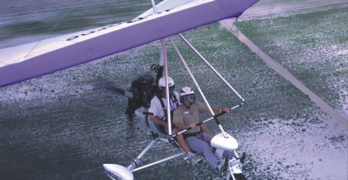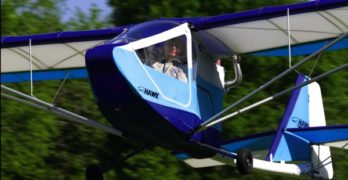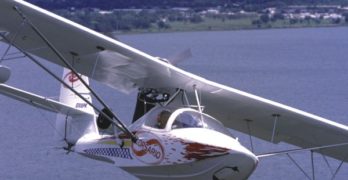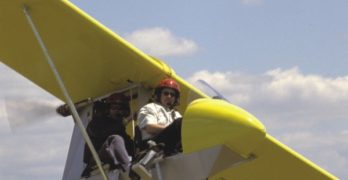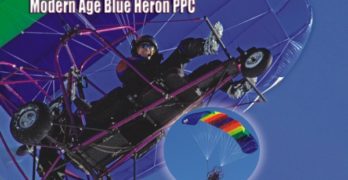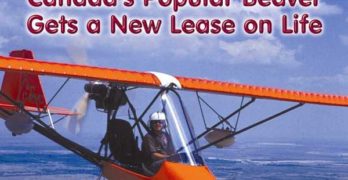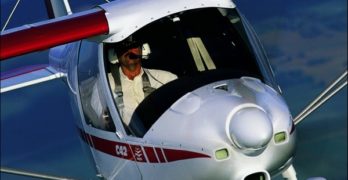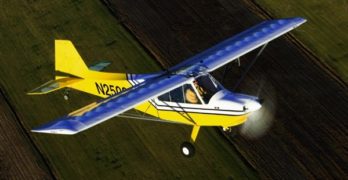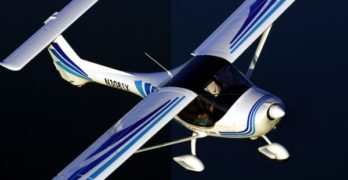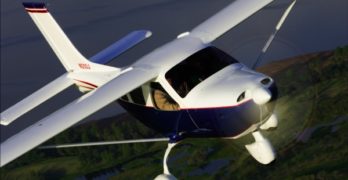For years now, the boys from “down under” at AirBorne Australia, led by co-owner Russell Duncan, have been coming to America. The ultralight they have been showing is the deluxe Edge Executive model. It’s a beauty, but the company lacked a simpler, lower-cost model. No more!
In April of last year, Duncan and crew debuted what they call the Edge X Wizard model. The “Edge X” series refers to the new trike carriage, above which you can have the double-surface Edge wing, making the Executive trike, or you can select the new single-surface Wizard wing. It is this new offering that is the focus of this pilot’s report.
Smoothly finished in all-white powder coating, and lacking the nose pod and aft fairing, the new Edge X trike carriage looks light and basic. At only $11,700 fully assembled, it should find a market in the USA, I feel. (The figure is complete in every way except for an import shipping charge, which U.S.
Search Results for : CT AND hand control
Not finding exactly what you expected? Try our advanced search option.
Select a manufacturer to go straight to all our content about that manufacturer.
Select an aircraft model to go straight to all our content about that model.
CGS Pulls Out the Stops
… to keep the Hawk Ultra Light
Genuine ultralights still
have a place. These
aircraft|excuse me,
ultralight vehicles,
the least-FAA-regulated
flying machines,
will not be sent to aircraft boneyards
despite what some light-sport aircraft
skeptics may think. The Hawk Ultra
is proof positive CGS Aviation loves
ultralights and wants you to have fun
in the air.
No matter the pros and cons of
the sport pilot/light-sport aircraft (SP/
LSA) rule, operating a Part 103 ultralight
remains simpler than earning a
sport pilot certificate and buying an
LSA. No certificate, no medical, and
no registration is needed (though, it is
recommended that folks register with
one of the three associations supporting
ultralights-EAA, the United States
Ultralight Association (USUA), and Aero
Sports Connection (ASC). Additionally,
an ultralight can be fully factory built
without FAA inspections. The list of 103
privileges goes on, and the Hawk Ultra
qualifies for all of them.
One-Oh-Three Interest Soars
I don’t know about the “build it
and they will come” premise when
it comes to baseball fields, but I fervently
believe that if enough customers
want a product, someone will supply
it.
Boathull Corsario Arrives in America
Brazilian Amphibious Beauty
Most Americans
are unaware of the Corsario. Importer Steven Cohen is out to change that. He and his partner, Phil Klein, are marketing this handsome amphibian, which they import from Brazil. Not a brand-new design, this is the MK5 model – it’s been through four previous iterations.
The Corsario comes from a South American company called Microleve founded in 1982, back near the beginning of the ultralight era. The company proudly states, “Aside from being the first ultralight manufacturer in Brazil, the quality of our products has made Microleve the biggest seller of ultralight aircraft in Latin America.”
In 23 years of operation, Microleve claims to have delivered more than 1,400 ultralight aircraft, including almost 20 different models, named as MX1, MX2, ML200, ML300, ML300M, ML300MF, ML400, ML400T, ML450, ML500T, CORSARIO MK1, MK2, MK3, MK4, and MK5. As you might surmise by reviewing this list, the Brazilian company has taken several of their models through a series of refinements and the Corsario is no exception.
The Lil’ Breezy B-Model
Open-Cockpit 2-seater
ust when you felt as though Light-Sport Aircraft (LSA) was the only segment of aviation getting any press, along comes a flying machine that harks back to the early days of ultralighting but with a distinctive fuselage construction and composite wings.
Just when it seemed like every new LSA had to be enclosed, four-stroke-powered, fast, and have leather seats, along comes a new open-cockpit, mile-a-minute airplane that can easily carry two people on the power of a 50-hp Rotax 503. The leather is on your flight jacket.
The Lil’ Breezy B can weigh 350 pounds empty, fly at 60 mph, and sell for $12,500 (for all parts plus engine/prop but not your assembly labor). In my experience that sounds like an ultralight. Born in the new millennium, the Lil’ Breezy B is a modern ultralight.
Before we go fly, let’s examine the machine and talk to its developer, Jack Harper.
Modern Age Blue Heron PPC
Here we are
in the spring of 2006 wondering about the future of ultralights in an age seemingly gone crazy about Sport Pilot/Light-Sport Aircraft (SP/LSA). For powered parachute manufacturer Heldeberg Designs, the answer is easy. They’ve been preparing for the LSA program for a long time. How will they fare?
Today, we have a great divide* between ultralight pilots on one side and LSA enthusiasts on the other. The ultralight pilots see rather modest benefit to becoming Sport Pilots flying ultralights converted to Experimental Light-Sport Aircraft (ELSA). One major downside is that most such aircraft will have to settle a sales tax bill (states become aware of the aircraft when owners obtain their N-numbers). Other limitations include not flying over 10,000 feet or being required to perform an annual condition inspection. And this is by no means a complete gripes list.
The LSA contingent responds, “That ship has sailed. SP/LSA is here.
Beaver RX-550
Perhaps the most famous ultralight to come out of Canada is the Beaver. With a reported 2,200 units flying since the early 1980s, this is one of the most successful light aircraft ever. However, due to missteps by companies that previously manufactured the brand, this popular ultralight was nearly lost from the ultralight aviation landscape. Were it not for the Aircraft Sales and Parts (ASAP) company and the Holomis family, you might not have this choice today.
Originally the Beaver RX-550 came from a company called Spectrum Aircraft. A company reorganization left the ultralight in the hands of a company named Beaver RX Enterprises. Both these business names disappeared and today the ASAP brand carries the Beaver into the sky.
In 1993, a couple years after our last report on the Beaver1, the old company closed its doors and effectively stranded thousands of Beaver ultralight owners and all the dealerships that sold them.
C42…An Ideal Light-Sport Aircraft Trainer?
Germany’s most popular microlight flies to America
Some readers and enthusiasts are excited about the proposed sport pilot/light-sport aircraft rule, while others have taken a wait-and-see approach. Virtually all recreational pilots are full of anticipation and questions. In the meantime, aircraft developers are also preparing.
Of those aircraft likely to become new ready-to-fly light-sport aircraft (LSA), many hail from Europe because its microlight regulations are close to the expected definition of LSAs in the United States. Germany is home to many manufacturers that produce potential LSAs, including Comco Ikarus, makers of the C42 Ikarus. The company has produced more than 1,500 aircraft, of which more than 650 are the C42 model. It’s an aircraft that both general aviation and microlight pilots appreciate, noted by the fact that it is Germany’s best-selling microlight. Every year, the factory cranks out another 80 C42s.
The design was first produced in 1996. Rather than follow the design of the company’s older C22, which looks like a Flightstar II SL in its Fastback version, the C42 started fresh.
Proven again: Rans’ newly approved S-7LS
You’ve probably heard the tongue-in-cheek expression, “No good deed goes unpunished.”
RANS President Randy Schiitter knows this saying in a way no other light-sport aircraft
(LSA) producer can. When the company’s S-7 Courier earned special light-sport aircraft
(S-LSA) approval on October 24, 2005, it was the second time this aircraft
was certificated as a ready-to-fly (RTF) airplane, after first being designed as a kit.
RANS earned Primary Category certification
for this aircraft, as the S-7C
model, 10 years ago when that FAA regulation
was the latest big thing in aviation.
It took the Kansas company years
to complete that certification process,
but the recreational pilot certificate and
Primary Category certification failed
to meet industry expectations. After
spending lots of time and money earning
that approval, RANS didn’t jump
on the LSA bandwagon immediately.
The S-7 Courier was the first twoseat
aircraft produced by RANS, dating
to 1985 when the first prototype flew.
A Winner Among LSA (Allegro)
The Allegro is the value leader among LSA designs.
One year ago, the fi rst special light-sport aircraft
(S-LSA) were approved and delivery of S-LSA began.
A few brands stand above the rest in the number of
aircraft delivered. One of those is the Allegro 2000, imported into
the United States from the Czech Republic by Fantasy Air USA. Since May 19, 2005,
when the Allegro earned S-LSA approval, Fantasy Air has delivered more than 40 aircraft,
keeping owners Doug and Betty Hempstead busy.
One of the appealing factors of the Allegro 2000 is its price, which starts in the upper
$50,000 range for the flyaway version. An airplane with an attractive price has a clear
advantage over others with higher price tags. When that airplane flies well, is supported
well, and has the equipment desired by consumers, it’s likely to succeed.
Well-Established
Given its fast start, Fantasy Air USA
has reason for optimism, but the
Allegro design has a much longer
history outside this country.
Jabiru J250: A Great Cross Country LSA
What’s that airplane with the funny sounding name?
The question arises when pilots, unfamiliar with the new
brands introduced by the light-sport aircraft (LSA) category, try
to comprehend the name Jabiru.
“And this airplane company also makes its own engine?”
This second question frequently follows the first. Jabiru USA’s
Peter “Pete” Krotje and his staff must tire of the explanation.
“It’s JAB-i-roo,” I heard Pete reply patiently one day at EAA
AirVenture Oshkosh 2005. “And, yes, the company makes both
the airframe and engine.”
So begins the tale of this new airplane from the country down
under famous for kangaroos and cowboys who speak English
in a distinctly different way. Designed by Jabiru Australia of
Bundaberg West, Australia, the J250 and J170 recently earned
special light-sport aircraft (S-LSA) certification, which the
Calypso hopes to do soon as well.
It’s A Little Big Plane
As you walk up to the
J250, this modern, composite cruiser
looks like a small airplane, yet entering
the J250 is easy and, once inside, the
cockpit is surprisingly roomy, especially
given its enormous luggage area.
- « Previous Page
- 1
- …
- 44
- 45
- 46
- 47
- 48
- …
- 61
- Next Page »


